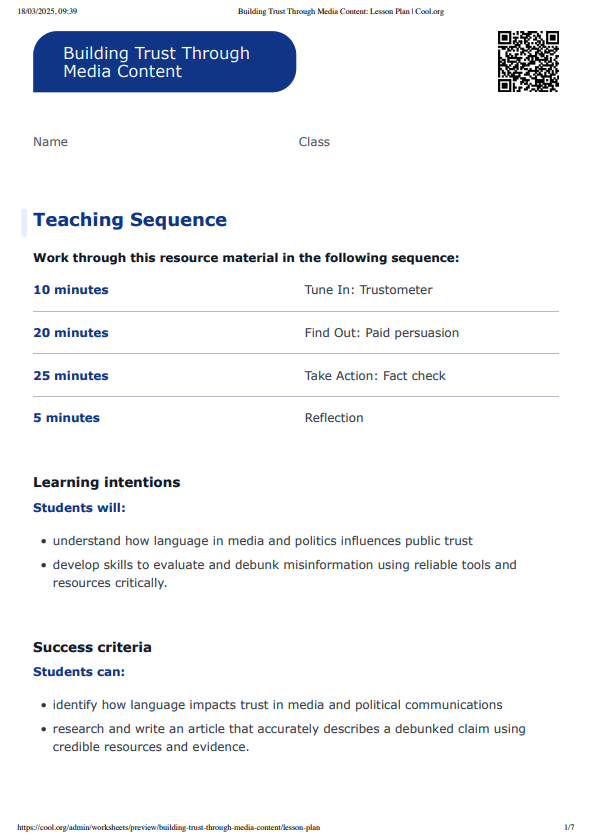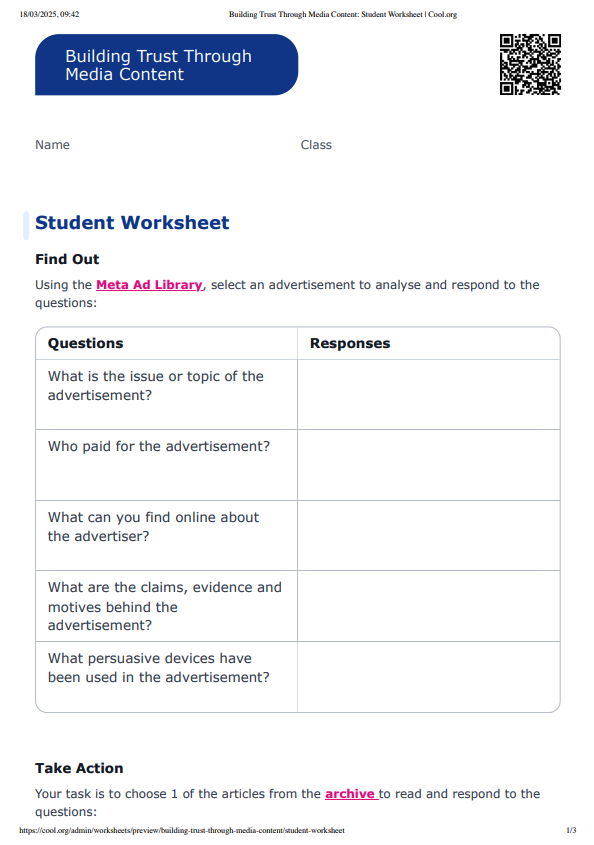Lesson summary
Students will investigate how political advertisements use persuasive devices and imagery to convey a particular message. They will analyse political advertisements and assess how organisations work to dispel misinformation and disinformation online.
Learning intentions
Students will:
- understand how language in media and politics influences public trust
- develop skills to evaluate and debunk misinformation using reliable tools and resources critically.
Success criteria
Students can:
- identify how language impacts trust in media and political communications
- research and write an article that accurately describes a debunked claim using credible resources and evidence.
Lesson guides and printables
Lesson details
Skills
This lesson is designed to build students’ competencies in the following skills:
- critical thinking
- communication
- community engagement
- digital literacy
- ethical understanding
- global citizenship
- reflection
Curriculum Mapping
Australian Curriculum (v9.0) content description:
Year 9, English
Students learn to:
- analyse how representations of people, places, events and concepts reflect contexts (AC9E9LY01).
Year 10, English
Students learn to:
- analyse and evaluate how people, places, events and concepts are represented in texts and reflect contexts (AC9E10LY01).
Relevant parts of Year 9 English achievement standards: Students analyse representations of people, places, events and concepts, and how texts respond to contexts.
Relevant parts of Year 10 English achievement standards:Students analyse and evaluate representations of people, places, events and how interpretations of these may be influenced by readers and viewers.
NSW Syllabus outcomes:
A student:
- analyses representations of ideas in literature through genre and theme that reflect perspective and context, argument and authority, and adapts these representations when creating texts (EN3-UARL-02).
General capabilities: Critical and Creative Thinking, Digital Literacy, Literacy, Personal and Social Capability, Ethical Understanding
Cross-curriculum priority: Sustainability
Level of teacher scaffolding: Medium - this lesson requires teacher modelling and demonstration of websites. The teacher will be required to explore the websites prior to students using these sites independently.
UN Sustainable Development Goals
- Target 4.7: By 2030, ensure that all learners acquire the knowledge and skills needed to promote sustainable development, including, among others, through education for sustainable development and sustainable lifestyles, human rights, gender equality, promotion of a culture of peace and non-violence, global citizenship and appreciation of cultural diversity and of culture’s contribution to sustainable development.
- Target 16.5: Substantially reduce corruption and bribery in all their forms
- Target 16.10: Ensure public access to information and protect fundamental freedoms, in accordance with national legislation and international agreements.
Resources Required
- Student devices
- Sticky notes
- Student Worksheet
- Whiteboard
Additional Info
Cool.org thanks our philanthropic funder, Boundless Earth for their generous contributions and collaboration in creating these resources.



Welcome back!
Don't have an account yet?
Log in with:
Create your free Cool.org account.
Many of our resources are free, with an option to upgrade to Cool+ for premium content.
Already have an account?
Sign up with:
By signing up you accept Cool.org's Terms and Conditions(Opens in new tab) and Privacy Policy(Opens in new tab).